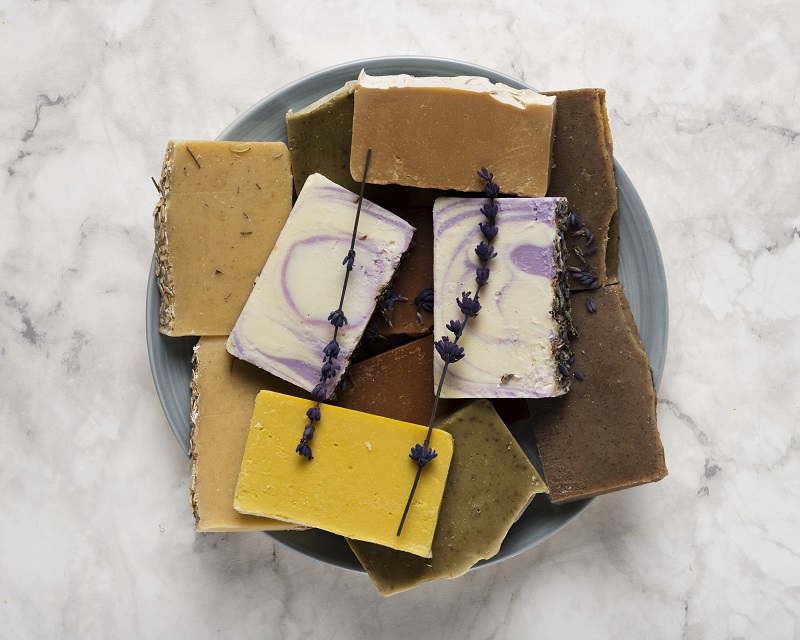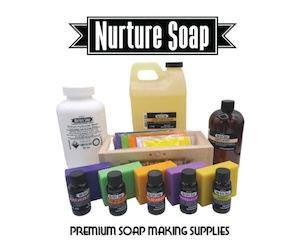How To Store Cold Process Soap:
This may seem like a slightly backwards approach, but we’d like to first talk about shelf life of soap. Then, we’ll discuss things like, how to unmold soap, how long to wait to unmold, cutting soap, how to store cold process soap, and the overall curing process.

Shelf Life of Cold Process Soap:
Probably as big of a question for sellers of soap, as it is for buyers. The expiration date or shelf life of cold process homemade soap is a top question for many soap makers!
Is there indeed an expiration date for soap?
You’ll likely here a common answer from many sellers and that is yes, and no! More then telling our customers when our soaps may “expire” it’s really a recommendation for the time period in which the soap should be used.
With cold process soap, one of the most commonly known indicators of a soap gone bad are called “dreaded orange spots”. Oftentimes, referred to as DOS.
When may these dreaded orange spots (DOS) show up?
The answer to this is not an exact science. It technically could be months (which we hope not), or years. One of the most important things for soapers, is to make sure we’re paying attention to the oils, and ingredients we use. These individual ingredients do have shelf lives.
Most of the time DOS occurs due to bad or rancid oils (as they start to oxidize and age). Even though they probably aren’t the most aesthetically or pleasantly smelling at this time (like old vegetable oil), you could actually still use them.
A thoughtful list where you can find the shelf life of many oils is at Brambleberry. They have tons of great information on soap making as well as cool DIY projects!
There is not an exact date we can give you. Some people may also think of expiration as when soaps lose their scent or aromas. Some aromas, whether that be fragrance oils or essential oils will loose their scents more quickly. Commonly due to the amount of time the soap has been curing.
Not all scents are created equal. Some oils lose their potency in the harsh environment of saponification. Alternatively, others loose it over cure time.
We recommended about a 2-4 month usage after opening our cold process soap. Most of our soaps cure for about 6-8 weeks prior to selling them. Thus, this allows for ample cure time and a hard bar of soap.
Related Article: Cleanup & Safety Tips for Soap Making: Let’s Chat About It
For Soap-Makers: Tips for Longevity!
- Use the freshest oils possible.
- Use distilled water, instead of tap. Tap water has many impurities.
- Store away from direct sunlight.
- Away from heat.
- Store in non-humid environments.
- Store in areas with good air circulation.
- There are theories about adding rosemary anti-oxidants to your batches. However, we have not experimented with this technique.
Unmolding & Curing Soap:
Oftentimes, when dealing with cold process soaps, the process of saponification (the oil/lye mixture becoming soap) will occur in roughly 48hrs.
Now, this doesn’t necessarily mean it is ready to be unmolded as several other factors influence this. For example,
- the amount of soft oils used in the recipe,
- whether it has went through full gel phase.
- Also, whether or not you used sodium lactate in your soap recipe.
As a general rule of thumb, we like to give our soap that “extra day”. Better to be safe then sorry. Now you can either continue to keep it covered or open it up to air at this time. However, we have even run into issues with soda ash, 3-4 days after the process of saponification. In this case, we like to keep it covered for an additional 24-hours.
Most of our soaps, unless we are using a high salt content in the soaps (where they harden much faster), we tend to leave our molds alone for 72-hours! With that said we have unmolded after just 24-hrs.
One of the easiest methods for telling whether your soap is ready to be unmolded is by simply pressing on the top of the soap loaf. If you can easily cause a dent in the soap, you probably should leave it alone for another 24-hours.
The last thing you want it to ruin your soap unmolding, regardless how hard it is to leave it alone.
Tip: For those of you who use wooden soap loaf molds, line it with freezer or wax paper. There are tons of tutorials on YouTube for doing this.
It’s an extra step, but it pays off big time and makes things much simpler when getting that heavy loaf of soap out of it’s mold. Other molds come with silicone liners, which are generally easy to work with as well. Silicone leaves a beautifully smooth/sheen look to the soap.
Tip: When unmolding your soap, it should be rid of all of its lye contents. Therefore, handling it without gloves is perfectly safe. However, you’ll want to where gloves when cutting and cleaning your soaps prior to selling, for obvious reasons.
One of the hardest parts of cold process soap making is the wait, right?
You make this beautiful bar of soap with all of these wonderful skin nourishing ingredients and now you have to wait to use.
Wait times for CP soaps can be upwards of 4, 6 even 8 weeks or longer. The reason for this, is to get the best quality, densest, and longest lasting bar of soap you can achieve. As time goes on the water will have evaporated out of the soap, making it very hard and fully cured.
Related Article: What Are IFRA Guidelines And How To Read Them!
Cutting Your Soap:
There are many options for cutting homemade cold process soap. From non-serrated kitchen knives to individual dough pastry scrappera. You can get fairly creative. Again, this may depend on whether you are using the soap personally or selling your soaps.
We swear by steel wire soap cutters, for a few different reasons, but the biggest one being they cut well, leaving little residue or mess behind when making a pass through the soap. Secondly, they cut such even bars of soap.
Besides the cost of some of them (which is certainly worth the price tag), these are a must have for sellers.
The size of each bar is also a personal preference. If you plan to sell your soaps, you need to cut them and price them accordingly to what it has cost you to make each batch, which is another entire article on it’s own!
Most often you will see CP soap bars cut into 1″, 1 1/4″ or 1 1/2″. If you think about making a 10″ soap loaf, which is a common size of beginner soap molds, this would make 10, 1″ bars, or 8, 1.25″ (1 1/4″) bars. These are nice starting points for figuring out prices as well. As your batches get bigger, you can “simply” start rescaling your numbers.
Places to find great soap molds are Brambleberry, Nurture Soap, or even ETSY! (These are NOT affiliate links). We personally have bought soap molds or cutters from these places.
How To Store Cold Process Soap:
Much of this information we mentioned earlier in the post. The last thing you want out of your homemade soap is for it to go rancid or expose it to an environment that doesn’t keep it fresh. After-all you did invest your time, money, and energy into the process.
A few of the most important aspects to keep in mind are;
- storing away from direct sunlight,
- avoiding humidity,
- and making sure your soaps are exposed to well ventilated areas.
Storage areas ideally are cool, and dry!
We have several wire racks that we allow them to cure and be stored on. If you do go this route, make sure the racks (metal) are coated, and whenever your are storing your soaps they should remain open to air flow, even after the 6-week cure time.
Final Thoughts!
That’s it on cutting, curing and storing your handmade cold process soaps. Whether you’re a seller or just a huge support of all natural cold process soaps, this article can help with the longevity of your soaps.
As always, be sure to share any of your tips with the community so we can all continue to learn together and become the best soap makers we can be!



